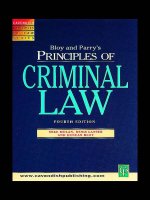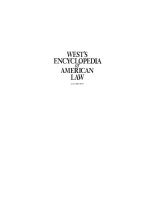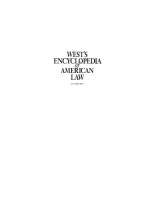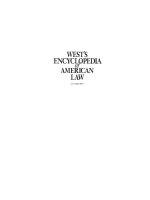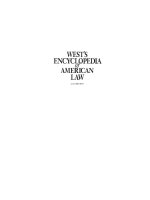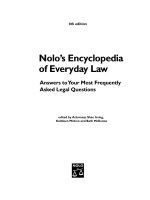encyclopedia of everyday law 4th (2002)
Bạn đang xem bản rút gọn của tài liệu. Xem và tải ngay bản đầy đủ của tài liệu tại đây (3.44 MB, 536 trang )
Nolo’s Encyclopedia
of Everyday Law
Answers to Your Most Frequently
Asked Legal Questions
edited by Attorneys Shae Irving,
Kathleen Michon and Beth McKenna
4th edition
About Nolo
Have a legal question? Chances are Nolo can help you answer it, both in print
and online.
For three decades, Nolo's mission has been to help people solve their legal
problems with confidence, a minimum of fuss and expense, and—whenever
possible—without a lawyer.
Over the years, we’ve offered every tool available to help you get the job done.
In the 70s, we began publishing practical, plain-English books containing all the
forms and step-by-step instructions necessary to tackle day-to-day legal tasks.
In the 80s, when personal computers took the world by storm, we got to
work and developed programs such as WillMaker and Living Trust Maker, which
took advantage of the speed and convenience of all those bits and bytes. We
also added form-packed disks and CDs to many of our books.
Then the Internet exploded in the 90s. Recognizing that it's best to get legal
information while sitting in your own comfy chair, Nolo started making useful,
up-to-date legal information available to anyone with a computer and a modem.
Most recently, we opened our online Download Center, where you can find all
of Nolo's convenient, topical eProducts. The fastest, easiest way to do your
own legal work, eProducts deliver specific forms and information directly to
your computer.
Does this mean we plan to abandon our books in print? Absolutely not. As
technology evolves and the Internet expands, we will continue to redesign
and improve all our current products, making your access to the law the best
it can be.
24
24
h urs a day
h urs a day
“America’s leading source of self-help legal
information.” ★★★★
—YAHOO!
LEGAL INFORMATION
LEGAL INFORMATION
ONLINE
ONLINE
ANYTIME
ANYTIME
www.nolo.com
AT THE NOLO.COM SELF-HELP LAW CENTER, YOU’LL FIND
•
Nolo’s comprehensive Legal Encyclopedia filled with plain-English
information on a variety of legal topics
•
Nolo’s Law Dictionary—legal terms without the legalese
•
Auntie Nolo—if you’ve got questions, Auntie’s got answers
•
The Law Store—over 250 self-help legal products including:
Downloadable Software, Books, Form Kits and eGuides
•
Legal and product updates
•
Frequently Asked Questions
•
NoloBriefs, our free monthly email newsletter
•
Legal Research Center, for access to state and federal statutes
•
Our ever-popular lawyer jokes
Law Books & Software
for Everyone
Nolo’s user-friendly products are consistently first-rate. Here’s why:
•
A dozen in-house legal editors, working with highly skilled authors,
ensure that our products are accurate, up-to-date and easy to use
•
We continually update every book and software program
to keep up with changes in the law
•
Our commitment to a more democratic legal system informs all of
our work
•
We appreciate & listen to your feedback. Please fill out and
return the card at the back of this book.
Quality
Our
“No-Hassle”
Guarantee
Return anything you buy
directly from Nolo for any
reason and we’ll cheerfully re-
fund your purchase price.
No ifs, ands or buts.
h
An Important Message to Our Readers
This product provides information and general advice about the law. But laws and
procedures change frequently, and they can be interpreted differently by different
people. For specific advice geared to your specific situation, consult an expert. No
book, software or other published material is a substitute for personalized advice
from a knowledgeable lawyer licensed to practice law in your state.
Nolo’s Encyclopedia
of Everyday Law
Answers to Your Most Frequently
Asked Legal Questions
edited by Attorneys Shae Irving,
Kathleen Michon and Beth McKenna
4th edition
iv
Keeping Up to Date
To keep its books up to date, Nolo issues new
printings and new editions periodically. New
printings reflect minor legal changes and
technical corrections. New editions contain
major legal changes, major text additions or
major reorganizations. To find out if a later
printing or edition of any Nolo book is
available, call Nolo at 510-549-1976
or
check our website at .
To stay current, follow the “Update” service at
our website: />update/list.cfm. In another effort to help you
use Nolo’s latest materials, we offer a 35%
discount off the purchase of the new edition of
your Nolo book when you turn in the cover of
an earlier edition.
This book was last revised in: May 2002.
Fourth Edition May 2002
Editors Shae Irving, Kathleen Michon
& Beth McKenna
Cover Jaleh Doane
Book Design Linda Marie Wanczyk
& Jackie Mancuso
Production Susan Putney
& Sarah Hinman
Index Nancy Mulvany
Proofreader Robert Wells
Printer Bertelsmann Services, Inc.
Nolo's encyclopedia of everyday law : answers to
your most frequently asked legal questions / edited
by Shae Irving, Kathleen Michon, and Beth
McKenna - 4th ed.
p. cm.
Includes index.
ISBN 0-87337-830-X
1. Law- -United States- -Popular works. 2. Law- -
United States- -Miscellanea. I. Irving, Shae. II.
Michon, Kathleen, 1966- III. McKenna, Beth.
KF387.N65 2002
349.73- -dc21 2002024251
ALL RIGHTS RESERVED. Printed in the U.S.A.
Copyright © 1996, 1999 and 2002 by Nolo.
No part of this publication may be reproduced,
stored in a retrieval system or transmitted in any
form or by any means, electronic, mechanical,
photocopying, recording or otherwise without the
prior written permission of the publisher and
the authors.
QUANTITY SALES: FOR INFORMATION ON
BULK PURCHASES OR CORPORATE
PREMIUM SALES, PLEASE CONTACT THE
SPECIAL SALES DEPARTMENT.
FOR ACADEMIC SALES OR TEXTBOOK
ADOPTIONS, ASK FOR ACADEMIC SALES.
800-955-4775, Nolo, 950 PARKER ST.,
BERKELEY, CA, 94710.
v
Dedication
For Edward F. Dolan
Acknowledgments
First things first—thanks to Jake Warner for
thinking up the project and providing the
support to get it done. And thanks to all the
Nolo editors who kept us (and the book) on
track, particularly Robin Leonard, for rising
above the call of duty, Mary Randolph for
her eminent good judgment and Steve Elias
for his relentless and contagious enthusiasm.
For diligent research help, we’d like to thank
Ella Hirst, Naomi Starkman and Peri
Pakroo. For helping manage the changes
through draft after draft of the earlier
editions, thanks go to Susan Cornell and
Stephanie Harolde.
Jackie Mancuso made the book look great.
Jaleh Doane, Susan Putney and Linda Marie
Wanczyk brought their sharp minds and
good humor to the design process, and made
the whole thing even easier.
Finally, we’re grateful to every Nolo author
and editor whose fine work has shaped these
pages. You’ll find many of these talented
folks listed in the Contributors section on
the following page. But we want to give
special thanks to:
Paul Bergman and Sara Berman-Barrett,
authors of Represent Yourself in Court and The
Criminal Law Handbook
David W. Brown, author of How to Change
Your Name and Beat Your Ticket: Go to Court
and Win!
Stephen Colwell and Ann Shulman, authors
of Trouble Free Travel…And What to Do
When Things Go Wrong
Frederick W. Daily, author of Stand Up to
the IRS, Tax Savvy for Small Business and
Surviving an Audit
James Evans, author of Law on the Net and
Government on the Net
Cora Jordan, author of Neighbor Law: Fences,
Trees, Boundaries & Noise and co-author
(with Denis Clifford) of Plan Your Estate
Mimi E. Lyster, author of Child Custody:
Building Agreements That Work
Joseph Matthews, author of How to Win
Your Personal Injury Claim and co-author
(with Dorothy Matthews Berman) of Social
Security, Medicare and Pensions
Tanya Starnes, author of Mad at Your
Lawyer
Fred S. Steingold, author of The Legal Guide
for Starting & Running a Small Business and
The Employer’s Legal Handbook.
vi
Contributors
Denis Clifford (Estate and Gift
Taxes). Denis is the author of several Nolo
books, including Nolo’s Will Book, The Quick
& Legal Will Book, Plan Your Estate (with
Cora Jordan) and The Partnership Book (with
Ralph Warner). A graduate of Columbia
Law School, where he was an editor of The
Columbia Law Review, Denis has practiced
law in various ways, and is convinced that
people can do much of their own legal work.
Amy DelPo (Workplace Rights,
Travel, Retirement Plans). Amy has been an
editor at Nolo since January 2000. She
specializes in workers’ rights, sexual harass-
ment law, employment law, criminal law
and civil litigation. She brings more than
six years of criminal and civil litigation
experience to her work at Nolo, having
litigated cases in all levels of state and
federal courts, including the California
Supreme Court and the United States
Supreme Court. Amy received her law
degree with Honors from the University of
North Carolina at Chapel Hill.
Stephen R. Elias (Patents, Copy-
rights, Trademarks, Criminal Law, Legal
Research). Steve received a law degree from
Hastings College of the Law in 1969. He
has practiced law in California, Vermont
and New York, working for a variety of
programs delivering legal services to the
poor. In 1980, he discovered Nolo and,
referring to himself as a recovering lawyer,
has never looked back. Steve has authored,
co-authored or edited over 30 Nolo titles
covering such topics as family law, patents,
copyrights, trademarks and bankruptcy.
Lisa Guerin
(Employers’ Rights and
Responsibilities). During her years as a law
student at Boalt Hall School of Law at the
University of California at Berkeley, Lisa
worked for Nolo as a research and editorial
assistant. After a stint as a staff attorney at
the U.S. Court of Appeals for the Ninth
Circuit, Lisa has worked primarily in the
field of employment law, in both government
and private practice. Lisa recently rejoined
the staff at Nolo, where she is the co-author
of Nolo’s Pocket Guide to California Law.
Shae Irving (Durable Powers of
Attorney for Finances, Wills and Estate
Planning). Shae graduated from Boalt Hall
School of Law at the University of California
at Berkeley in 1993 and began working for
Nolo in 1994. She has written extensively
on durable powers of attorney and other
estate planning issues. She edits many other
Nolo titles, including Plan Your Estate and
Make Your Own Living Trust.
Bethany K. Laurence (Small
Businesses). Beth graduated from Hastings
College of the Law at the University of
California in 1993. She spent several years
working for a corporate legal publisher
before coming to Nolo. She joined Nolo’s
editorial staff in 1997 and has never been
happier. Beth is the co-author of Nolo’s
How to Create a Buy-Sell Agreement & Control
the Destiny of Your Small Business and the
editor of several Nolo publications, includ-
ing The Small Business Start-Up Kit, Nolo’s
California Quick Corp and Nolo’s Quick LLC.
Robin Leonard (Your Money, Cars
and Driving, Traveling, Spouses and
Partners, Dealing With Your Lawyer).
Robin specializes in debt, credit, bank-
ruptcy and family law. She earned her law
degree from Cornell Law School in 1985.
vii
Robin is the author (or co-author) of many
Nolo books, including Money Troubles: Legal
Strategies to Cope With Your Debts, How to File
for Bankruptcy, Nolo’s Pocket Guide to Family
Law, Take Control of Your Student Loans and
Credit Repair.
Deanne Loonin (Your Money).
Deanne works with Nolo on debt and credit
issues. She is also a staff attorney with the
National Consumer Law Center (NCLC) in
Boston. Prior to joining Nolo and NCLC,
she directed Bet Tzedek Legal Service’s
senior consumer fraud unit in Los Angeles.
Deanne is the co-author of Surviving Debt: A
Guide for Consumers (NCLC) and Money
Troubles (Nolo).
Peter Lovenheim (Mediation). A 1979
graduate of Cornell Law School, Peter has
been an active mediator since 1986 and is
founder and president of a private dispute
resolution service. He is the author of
Mediate, Don’t Litigate (McGraw-Hill),
Reading Between the Lines: New Stories From
the Bible, with co-editor David Katz (Jason
Aronson), and Mediate Your Dispute (Nolo).
Peter lives in Rochester, New York, with
his wife and three children.
Anthony Mancuso (Nonprofit
Corporations). Tony is a California attorney
and the author of Nolo’s best-selling
corporate law series, including How to Form
Your Own Corporation (California, Texas,
New York and computer editions). He is
also the author of Nolo’s Taking Care of Your
Corporation series and the book How to Form
a Nonprofit Corporation. Tony is a jazz
guitarist and a licensed helicopter pilot.
Beth McKenna (Criminal Law and
Procedure, Changing Your Name). Beth
received her law degree from Stanford Law
School. Before coming to Nolo, she worked
as a public defender for five years, concen-
trating in appellate and habeas corpus law.
She is Nolo’s criminal law editor and is
responsible for Nolo’s best-selling Quicken
Lawyer Personal software.
Kathleen Michon (Cars and Driv-
ing, Legal Research, Retirement Plans).
Kathleen graduated cum laude from
Northwestern University School of Law in
1993. Prior to joining Nolo’s editorial staff,
Kathleen was the Directing Attorney of
Public Counsel’s Consumer Rights Project.
She is the editor of Nolo’s debt and credit
books, including Credit Repair and Money
Troubles, and is a co-
author of How to File for
Chapter 7 Bankruptcy.
Shannon Miehe (Small Businesses,
Dealing With the IRS). Shannon graduated
from the University of Southern California
Law School. She then spent several years
representing small and mid-size entrepre-
neurial companies in connection with
mergers, acquisitions and business forma-
tion issues. At Nolo, Shannon edits small
business products, including Legal Forms for
Starting & Running a Small Business, The
Partnership Book and How to Form Your Own
California Corporation.
Janet Portman (Landlords and
Tenants). Janet received undergraduate and
graduate degrees from Stanford University
and a law degree from the University of
Santa Clara. She was a public defender
before coming to Nolo. Janet is Nolo’s
Publisher and the editor of several Nolo
books, including Legal Research: How to Find
& Understand the Law and The Criminal
Records Book. She is the co-author of Nolo’s
Every Landlord’s Legal Guide, Every Tenant’s
Legal Guide and Renters’ Rights.
viii
Mary Randolph (Deeds, Neigh-
bors, Wills and Estate Planning). Mary has
been editing and writing Nolo books and
software for more than a decade. She earned
her law degree from Boalt Hall School of
Law at the University of California at
Berkeley, and her undergraduate degree at
the University of Illinois. She is the author
of Dog Law, The Deeds Book, 8 Ways to Avoid
Probate and other Nolo materials.
Barbara Kate Repa (Workplace
Rights, Employers’ Rights and Responsi-
bilities, Funeral Planning and other Final
Arrangements, Body and Organ Donations,
Healthcare Directives, Older Americans,
Traffic Accidents). Barbara Kate, a lawyer,
has written several books for Nolo, includ-
ing Your Rights in the Workplace, and Sexual
Harassment on the Job.
Linda Robayo (Spouses and Partners,
Parents and Children). Linda graduated
from Boston College in 1989 and Seton
Hall University School of Law in 1995.
Linda practiced law with the Community
Health Law Project and Ocean-Monmouth
Legal Services in New Jersey for three years.
She is currently a public relations executive
for the Center for Reproductive Law and
Policy in New York City. Linda has written
articles for Nolo and has been published in
national publications such as Good House-
keeping and Mademoiselle.
Spencer Sherman
(Older Americans).
Spencer has edited several Nolo books,
including Beat Your Ticket, Fight Your Ticket
(California Edition), How to Get a Green
Card and U.S. Immigration Made Easy. A
journalist for many years, he reported on
legal issues in California and from the U.S.
Supreme Court.
Marcia Stewart (Houses, Landlords
and Tenants). Marcia is an expert on land-
lord-tenant law, buying and selling houses
and other issues of interest to consumers.
She is the co-author of Nolo’s Every
Landlord’s Legal Guide, Every Tenant’s Legal
Guide, Renters’ Rights, Leases & Rental
Agreements and editor of Nolo’s LeaseWriter
software for landlords.
Richard Stim (Patents, Copyrights,
Trademarks). Rich graduated from the
University of San Francisco Law School in
1984 and worked in private practice for 16
years until joining Nolo as an editor in
2000. He is the author of License Your
Invention, Getting Permission, Music Law, and
is the co-author with David Pressman of
Nolo’s Patents for Beginners.
Ralph Warner (Courts and Media-
tion). Ralph is the co-founder and Publisher
of Nolo. He is the author (or co-author) of a
number of Nolo books, including Every
Landlord’s Legal Guide, Everybody’s Guide to
Small Claims Court, The Partnership Book and
Get a Life: You Don’t Need a Million to Retire
Well. Ralph is a lawyer who became fed up
with the legal system and as a result has
dedicated his professional life to making
law more accessible and affordable to all
Americans.
ix
Table of Contents
About This Book
1
ef
Houses
1.2 Buying a House
1.9 Selling Your House
1.15 Deeds
2
ef
Neighbors
2.2 Boundaries
2.3 Fences
2.4 Trees
2.6 Views
2.8 Noise
3
ef
Landlords and
Tenants
3.2 Leases and Rental
Agreements
3.4 Tenant Selection
3.4 Housing
Discrimination
3.6 Rent and Security
Deposits
3.8 Tenants’ Privacy Rights
3.9 Repairs and Maintenance
3.12 Landlord Liability for
Criminal Acts and
Activities
3.14 Landlord Liability for
Lead Poisoning
3.15 Landlord’s Liability for
Exposure to Asbestos
and Mold
3.16 Insurance
3.17 Resolving Disputes
4
ef
Workplace Rights
4.2 Fair Pay and Time Off
4.9 Workplace Health
and Safety
4.12 Workers’ Compensation
4.17 Age Discrimination
4.21 Sexual Harassment
4.25 Disability
Discrimination
4.29 Losing or Leaving
Your Job
5
ef
Small Businesses
5.2 Before You Start
5.8 Legal Structures
for Small Businesses
5.15 Nonprofit Corporations
5.18 Small Business Taxes
x
5.24 Home-Based Businesses
5.29 Employers’ Rights &
Responsibilities
6
ef
Patents
6.2 Qualifying for a Patent
6.7 Obtaining a Patent
6.9 Enforcing a Patent
6.12 Putting a Patent
to Work
6.14 How Patents Differ From
Copyrights and
Trademarks
7
ef
Copyrights
7.2 Copyright Basics
7.4 Copyright Ownership
7.6 Copyright Protection
7.10 Copyright Registration
and Enforcement
8
ef
Trademarks
8.2 Types of Trademarks
8.5 Trademark Protection
8.8 Using and Enforcing a
Trademark
8.11 Conducting a
Trademark Search
8.14 Registering a
Trademark
8.18 How Trademarks
Differ
From Patents and
Copyrights
9
ef
Your Money
9.2 Purchasing Goods and
Services
9.7 Using Credit and
Charge Cards
9.11 Using an ATM or Debit
Card
9.11 Strategies for Repaying
Debts
9.18 Dealing With the IRS
9.22 Debt Collections
9.25 Bankruptcy
9.28 Rebuilding Credit
10
ef
Cars and Driving
10.2 Buying a New Car
10.7 Leasing a Car
10.10 Buying a Used Car
10.12 Financing a Vehicle
Purchase
10.13 Insuring Your Car
10.16 Your Driver’s License
xi
10.19 If You’re Stopped by the
Police
10.21 Drunk Driving
10.23 Traffic Accidents
11
ef
Travel
11.2 Airlines
11.11 Rental Cars
11.16 Hotels and Other
Accommodations
11.21 Travel Agents
11.25 Travel Scams
12
ef
Wills and Estate
Planning
12.2 Wills
12.8 Probate
12.9 Executors
12.13 Avoiding Probate
12.15 Living Trusts
12.18 Estate and Gift Taxes
12.22 Funeral Planning and
Other Final Arrangements
12.25 Body and Organ
Donations
13
ef
Healthcare
Directives and
Powers of Attorney
13.2 Healthcare Directives
13.7 Durable Powers of
Attorney for Finances
13.11 Conservatorships
14
ef
Older Americans
14.2 Social Security
14.8 Medicare
14.12 Pensions
14.19 Retirement Plans
15
ef
Spouses and
Partners
15.2 Living Together—Gay
& Straight
15.6 Premarital Agreements
15.8 Marriage
15.16 Divorce
15.26 Domestic Violence
15.29 Changing Your Name
xii
16
ef
Parents and
Children
16.2 Adopting a Child
16.12 Stepparent Adoptions
16.14 Adoption Rights:
Birthparents,
Grandparents and
Children
16.18 Child Custody and
Visitation
16.25 Child Support
16.31 Guardianship of
Children
17
ef
Courts and
Mediation
17.2 Representing Yourself
in Court
17.13 Small Claims Court
17.21 Mediation
17.27 Dealing With Your
Lawyer
18
ef
Criminal Law
and Procedure
18.2 Criminal Law and
Procedure: An Overview
18.8 If You Are Questioned
by the Police
18.10 Searches and Seizures
18.14 Arrests and
Interrogations
18.17 Bail
18.20 Getting a Lawyer
Appendix:
Legal Research
Glossary
ef
About This Book
Whether we like it or not, the law
touches our personal lives in many ways
each day. We may not think much
about the laws that affect us as we carry
out simple tasks such as driving a car,
making a telephone call or buying milk
at the corner grocery store. But every
now and again, we’re sure to need an
answer to a common legal question that
arises in the course of daily life:
What can I do about my noisy neighbor?
WHAT ARE MY RIGHTS IF I’M FIRED
FROM
MY JOB?
Do I really need to make a will?
What should I do if I can’t pay the child
support I owe?
And so on.
This book provides answers to fre-
quently asked questions about more
than 100 subjects you might encounter
in your personal life—topics that range
from buying a house to getting a di-
vorce, from paying your debts to start-
ing and running a small business. Ob-
viously, we can’t answer every question
on a particular subject, but we’ve an-
swered many common ones to get you
started. Throughout each chapter,
you’ll find resource boxes listing
sources for more information about a
particular subject.
In addition, for those of you who
are computer savvy, each chapter con-
tains a list of online sites that will
help you learn more about a particu-
lar area of the law. Look for the “On-
line Help” icon as you read. And if
you need more information about
finding the law, The Legal Research
Appendix contains a section that
shows you how to do basic legal re-
search—with a focus on searching the
Internet.
Think of this book as a desk refer-
ence—a little encyclopedia that
unpacks the law and puts it in your
hands in a language you can under-
stand. But remember that the law
changes constantly as legislatures pass
new laws and courts hand down their
rulings. We will publish new, revised
editions of this book periodically, but
it will never be perfectly current. It’s
always your responsibility to be sure a
law is up to date before you rely on
it. Check the Legal Update Service on
our website at
for the most current legal informa-
tion affecting Nolo books & software.
i
ab
•
l
l
l
l
l
l
l
l
l
l
l
l
l
l
l
l
l
l
l
l
l
l
eeef
l
l
l
•
1
Houses
1.2 Buying a House
1.9 Selling Your House
1.15 Deeds
Home is heaven for beginners.
—CHARLES H. PARKHURST
Buying or selling a house is a major undertaking. To do it
right, you need to understand how houses are priced, financed
and inspected; how to find and work with a real estate agent; how
to protect your interests when negotiating a contract; and how
legal transfer of ownership takes place. This chapter covers many
of the basic issues that buyers, sellers and owners need to know.
N o l o ’ s E n c y c l o p e d i a o f E v e r y d a y L a w
1. 2
l
l
l
l
l
l
l
l
l
l
l
l
l
l
l
l
l
l
l
l
l
l
l
l
l
l
l
Buying
a House
Before you look for a house, it’s essen-
tial to determine how much you can
afford to pay and what your financing
options are. You’ll also need to decide
whether you want to work with a real
estate agent or broker, and finally,
even if you think you’ve found your
dream home, you’ll need to master the
ins and outs of house inspections. This
section will help you find your way
through the house-buying maze—and
to your new front door.
I’m a first-time home buyer.
Is there any easy way to
determine how much house
I can afford?
As a broad generalization, most
people can afford to purchase a house
worth about three times their total
(gross) annual income, assuming a
20% down payment and a moderate
amount of other long-term debts,
such as car or student loan payments.
With no other debts, you can prob-
ably afford a house worth up to four
or even five times your annual in-
come.
The most accurate way to deter-
mine whether you can afford a par-
ticular house is to total up the esti-
mated monthly principal and interest
payments plus one-twelfth of the
yearly bill for property and home-
owner’s insurance. Now compare that
to your gross monthly income.
Lenders normally want you to make
all monthly housing payments with
28%-38% of your monthly income—
the percentage depends on the amount
of your down payment, the interest
rate on the type of mortgage you
want, your credit history, the level of
your long-term debts and other fac-
tors. A bank or other lender can help
you determine how much house you
can afford.
Or you can run the numbers your-
self, using an online mortgage calcu-
lator such as those on the websites
listed at the end of this chapter.
Once you’ve done the basic calcula-
tions, you can ask a lender or loan
broker for a prequalification letter
saying that loan approval for a speci-
fied amount is likely based on your
income and credit history. Prequali-
fying lets you determine exactly how
much you’ll be able to borrow and
how much you’ll need for a down pay-
ment and closing costs.
Unless you’re in a very slow mar-
ket, with lots more sellers than buy-
ers, you will want to do more than
prequalify for a loan—you will want
to be guaranteed for a specific loan
amount. This means that the lender
actually evaluates your financial situa-
tion, runs a credit check and preap-
proves you for a loan—rather than
giving a general prequalification
based on your own statement about
your income and debts. Having lender
preapproval for a loan makes you more
attractive financially to sellers than
simple loan prequalification and is
crucial in competitive markets. With-
out it, you stand very little chance of
your offer being accepted.
H O U S E S
1. 3
l
l
l
l
l
l
l
l
l
l
l
l
l
l
l
l
l
l
l
l
l
l
l
l
l
l
l
How important is my credit
history in getting loan approval?
Your credit history has an important
effect on the type and amount of loan
lenders offer you. When reviewing
loan applications and making financ-
ing decisions, lenders typically re-
quest your credit risk score from the
credit bureaus. This score is a statisti-
cal summary of the information in
your credit report and includes:
• your history of paying bills on time
• the level of your outstanding debts
• how long you’ve had credit
• your credit limit
• the number of inquiries for your
credit report (too many can lower
your score), and
• the types of credit you have.
The higher your credit score, the
easier it will be to get a loan. If you
routinely pay your bills late, you can
expect a lower score, in which case a
lender may either reject your loan
application altogether or insist on a
very large down payment or high
interest rate to lower the lender’s risk.
To avoid problems, always check
your credit report and clean up your
file if necessary—before, not after, you
apply for a mortgage. For information
on how to order your credit report,
what to do if you find mistakes in
your report and how to rebuild good
credit, see Rebuilding Credit in Chapter
9, Your Money.
How can I find the best home
loan or mortgage?
Many entities, including banks, credit
unions, savings and loans, insurance
companies and mortgage bankers
make home loans. Lenders and terms
change frequently as new companies
appear, old ones merge and market
conditions fluctuate. To get the best
deal, compare loans and fees with at
least a half-dozen lenders. Fortu-
nately, mortgage rates and fees are
usually published in the real estate
sections of metropolitan newspapers
and are widely available on the
Internet.
Because many types of home loans
are standardized to comply with rules
established by the Federal National
Mortgage Association (Fannie Mae)
and other quasi-governmental corpo-
rations that purchase loans from lend-
ers, comparison shopping is not diffi-
cult, especially if you go online.
Mortgage rate websites come in
two basic flavors: those sites that
don’t offer loans (called “no-loan”
sites) and those that do. No-loan sites
don’t broker or lend mortgage money,
but are a great place to examine mort-
gage programs, learn mortgage lingo,
understand underwriting, get ques-
tions answered about the loan qualifi-
cation process, crunch numbers with
online mortgage calculators and check
your credit.
Many online mortgage sites also
offer direct access to loans from one or
more lenders. With multi-lender
shopping sites, you simply enter the
loan amount, property details and
other information and you’ll get cur-
rent rates, APR, points, even settle-
ment costs for each loan from dozens
of lenders. If you choose to complete
N o l o ’ s E n c y c l o p e d i a o f E v e r y d a y L a w
1. 4
l
l
l
l
l
l
l
l
l
l
l
l
l
l
l
l
l
l
l
l
l
l
l
l
l
l
l
an application, mortgage shopping
sites review your application, process
the required documentation and ship
your loan to the lender for further
review and underwriting.
See the list of recommended
websites at the end of this chapter for
more information on mortgage
websites.
If you don’t want to shop for mort-
gages on your own, you can also work
with a loan broker, someone who spe-
cializes in matching house buyers
with an appropriate mortgage lender.
Loan brokers usually collect their fee
from the lender.
What are my other options for
home loans?
You may also be eligible for a gov-
ernment-guaranteed loan, offered by:
• the Federal Housing Administration
(FHA), an agency of the Depart-
ment of Housing and Urban Devel-
opment (HUD) (see http://
www.hud.gov/mortprog.html)
• the U.S. Department of Veterans
Affairs (see eloans.
va.gov), or
• a state or local housing agency.
Government loans usually have low
down payment requirements and
sometimes offer better-than-market
interest rates as well.
Also, ask banks and other private
lenders about any “first-time buyer
programs” that offer low down pay-
ment plans and flexible qualifying
guidelines to low and moderate in-
come buyers with good credit.
Finally, don’t forget private sources
of mortgage money—parents, other
relatives, friends or even the seller of
the house you want to buy. Borrowing
money privately is usually the most
cost-efficient mortgage of all.
What’s the difference between
a fixed and an adjustable rate
mortgage?
With a fixed rate mortgage, the inter-
est rate and the amount you pay each
month remain the same over the en-
tire mortgage term, traditionally 15,
20 or 30 years. A number of variables
are available, including five- and
seven-year fixed rate loans with bal-
loon payments at the end.
With an adjustable rate mortgage
(ARM), the interest rate fluctuates as
the interest rates in the economy fluc-
tuate. Initial interest rates of ARMs
are usually offered at a discounted
(“teaser”) rate which is lower than
those for fixed rate mortgages. Over
time, however, initial discounts are
filtered out and ARM rates fluctuate
as general interest rates go up or
down. To avoid constant and drastic
changes, ARMs typically regulate
(cap) how much and how often the
interest rate and/or payments can
change in a year and over the life of
the loan. A number of variations are
available for adjustable rate mort-
gages, including hybrids that change
from a fixed to an adjustable rate after
a period of years.
A good loan officer or loan broker
will walk you through all mortgage
options and tradeoffs such as higher
fees (or points) for a lower interest rate.
H O U S E S
1. 5
l
l
l
l
l
l
l
l
l
l
l
l
l
l
l
l
l
l
l
l
l
l
l
l
l
l
l
How do I decide whether to
choose a fixed or an adjustable
rate mortgage?
Because interest rates and mortgage
options change often, your choice of a
fixed or an adjustable rate mortgage
should depend on the interest rates
and mortgage options available when
you’re buying, how much you can
afford in the short term, your view of
the future (generally, high inflation
will mean that ARM rates will go up
and lower inflation means that they
will fall), and how willing you are to
take a risk. Very risk-averse people
usually prefer the certainty of a fixed
rate mortgage, rather than take a
chance that an ARM might be cheaper
in the long run. However, some
people can’t afford the relatively
higher interest rates at which fixed
rate mortgages usually begin.
Keep in mind that lenders not only
lend money to purchase homes; they
also lend money to refinance homes. If
you take out a loan now, and several
years from now interest rates have
dropped, refinancing may be an option.
What’s the best way to find and
work with a real estate agent or
broker?
Get recommendations from people
who have purchased a house in the
past few years and whose judgment
you trust. Don’t work with an agent
you meet at an open house or find in
the Yellow Pages or on the Internet
unless and until you call references
and thoroughly check the person out.
The agent or broker you choose should
be in the full-time business of selling
real estate and should have the follow-
ing five traits: integrity, business so-
phistication, experience with the type
of services you need, knowledge of the
area where you want to live and sensi-
tivity to your tastes and needs.
All states regulate and license real
estate agents and brokers. You may
have different options as to the type of
legal relationship you have with an
agent or broker; typically, the seller
pays the commission of the real estate
salesperson who helps the buyer locate
the seller’s house. The commission is a
percentage (usually 5% to 7%) of the
sales price of the house. What this
means is that your agent or broker has
a built-in conflict of interest: Unless
you’ve agreed to pay her separately,
she won’t get paid until you buy a
home, and the more you pay for a
house, the bigger her cut.
In short, when you evaluate the
suitability of a house, it’s not wise to
rely principally on the advice of a per-
son with a significant financial stake in
your buying it. You need to be knowl-
edgeable about the house-buying pro-
cess, your ideal affordable house and
neighborhood, your financing needs
and options, your legal rights and how
to evaluate comparable prices.
What’s the best way to get
information on homes for sale
and details about the
neighborhood?
Thanks to the Internet, you no longer
have to rely solely on a real estate
agent for information about homes for
sale. You can scan online listings to
see which homes are worth a visit,
N o l o ’ s E n c y c l o p e d i a o f E v e r y d a y L a w
1. 6
l
l
l
l
l
l
l
l
l
l
l
l
l
l
l
l
l
l
l
l
l
l
l
l
l
l
l
how much they cost and what ameni-
ties they offer. Virtual visits to new
homes often include floor plans and
photographs.
Once you identify a house you like,
you can email the address or identifi-
cation number to your agent, the list-
ing agent or the owner (if it’s a listing
by a FSBO—For Sale By Owner) to
obtain additional information or to set
up an appointment to see the home in
person.
The list of websites at the end of
this chapter has some of the major
national real estate listing sites. Your
state or regional realty association or
multiple listing service (MLS) may
also have a website listing homes for
sale. Major real estate companies, in-
cluding ERA, RE/MAX, Coldwell
Banker, Prudential and others often
offer lists on their websites.
Finally, virtually all online editions
of newspapers offer a homes-for-sale
classifieds section that works much
like an online listing site. On most
newspaper sites, you can browse all
the listings, or customize your search
by typing in your criteria, such as
price range, location and number of
bedrooms and baths. Some of the best
sites also include useful information
on mortgage rates, schools and other
community resources, financial calcu-
lators, links to sales data on compa-
rable houses, home inspection ser-
vices, real estate agents and other in-
formation of interest to local buyers.
Check the Newspaper Association of
America () for a
link to your newspaper. (Click on
“Newspaper Links.”)
Advice on relocation decisions and
details about your new community
and its services are also readily avail-
able online. For valuable information
about cities, communities and neigh-
borhoods, including schools, housing
costs, demographics, crime rates and
jobs, see the websites listed at the end
of this chapter. Finally, keep in mind
that the Internet is no substitute for
your own legwork. Ask your friends
and colleagues, walk and drive around
neighborhoods, talk to local residents,
read local newspapers, visit the local
library and planning department and
do whatever it takes to help you get a
better sense of a neighborhood or city.
My spouse and I want to buy a
$350,000 house. We have
good incomes and can make
high monthly payments, but we
don’t have $70,000 to make a
20% down payment. Are there
other options?
Assuming you can afford (and qualify
for) high monthly mortgage payments
and have an excellent credit history,
you should be able to find a low (10%
to 15%) down payment loan for a
$350,000 house. However, you may
have to pay a higher interest rate and
loan fees (points) than someone mak-
ing a higher down payment. In addi-
tion, a buyer who puts less than 20%
down should be prepared to purchase
private mortgage insurance (PMI),
which is designed to reimburse a mort-
gage lender up to a certain amount if a
buyer defaults and the foreclosure sale
price is less than the amount owed the
H O U S E S
1. 7
l
l
l
l
l
l
l
l
l
l
l
l
l
l
l
l
l
l
l
l
l
l
l
l
l
l
l
lender (the mortgage plus the costs of
the foreclosure sale).
PMI premiums are usually paid
monthly and typically cost less than
one-half of one percent of the mort-
gage loan. With the exception of
some government and older loans, you
can drop PMI once your equity in the
house reaches 22% and you’ve made
timely mortgage payments.
I want to buy a newly built
house. Is there anything special
I need to know?
The most important factor in buying
a newly built house is not what you
buy (that is, the particular model),
but rather from whom you buy. New
is not always better, especially if the
house is slapped together in a hurry.
Shop for an excellent builder—some-
one who builds quality houses, deliv-
ers on time and stands behind his or
her work. To check out a particular
builder, talk to existing owners in the
development you’re considering, or ask
an experienced contractor to look at
other houses the developer is building.
Many developers of new housing
will help you arrange financing; some
will also pay a portion of your monthly
mortgage or subsidize your interest
payments for a short period of time
(called a “buydown” of the mortgage).
As with any loan, be sure you com-
parison shop before arranging financ-
ing through a builder.
Also, be sure to negotiate the prices
of any add-ons and upgrades, such as a
spa or higher quality carpet. These
can add substantially to the cost of a
new home.
Is there anything else I need to
know before buying a home in
a development run by a
homeowners’ association?
When you buy a home in a new sub-
division or planned unit development,
chances are good that you also auto-
matically become a member of an
exclusive club—the homeowners’
association, whose members are the
people who own homes in the same
development. The homeowners’ asso-
ciation will probably exercise a lot of
control over how you use and what
you do to your property.
Deeds to houses in new develop-
ments almost always include restric-
tions—from the colors you can paint
your house to the type of front yard
landscaping you can do to where (and
what types of vehicles) you can park
in your driveway. Usually, these re-
strictions, called covenants, conditions
and restrictions (CC&Rs), put deci-
sion-making rights in the hands of a
homeowners’ association. Before buy-
ing, study the CC&Rs carefully to see
if they’re compatible with your
lifestyle. If you don’t understand
something, ask for more information
and seek legal advice if necessary.
Usually, getting relief from overly
restrictive CC&Rs after you move in
isn’t easy. You’ll likely have to submit
an application (with fee) for a vari-
ance, get your neighbors’ permission
and possibly go through a formal
hearing. And if you want to make a
structural change, such as building a
fence or adding a room, you’ll prob-
ably need formal permission from the
association in addition to complying
with city zoning rules.
N o l o ’ s E n c y c l o p e d i a o f E v e r y d a y L a w
1. 8
l
l
l
l
l
l
l
l
l
l
l
l
l
l
l
l
l
l
l
l
l
l
l
l
l
l
l
How can I make sure that the
house I’m buying is in good
shape?
In some states, you may have the ad-
vantage of a law that requires sellers
to disclose considerable information
about the condition of the house. (See
Selling Your House, below.) Regardless
of whether the seller provides disclo-
sures, however, you should have the
property inspected for defects or mal-
functions in the building’s structure.
Start by conducting your own in-
spection. There are several useful do-
it-yourself inspection books available
to help you learn what to look for.
Ideally, you should inspect a house
before you make a formal written offer
to buy it so that you can save yourself
the trouble should you find serious
problems.
If a house passes your inspection,
hire a general contractor to check all
major house systems from top to bot-
tom, including the roof, plumbing,
electrical and heating systems and
drainage. This will take two or three
hours and cost you anywhere from
$200 to $500 depending on the loca-
tion, size, age and type of home. You
should accompany the inspector dur-
ing the examination so that you can
learn more about the maintenance and
preservation of the house and get an-
swers to any questions you may have,
including which problems are impor-
tant and which are relatively minor.
Depending on the property, you may
want to arrange specialized inspections
for pest damage, hazards from floods,
earthquakes and other natural disasters
and environmental health hazards such
as asbestos, mold and lead.
Professional inspections should be
done after your written purchase offer
has been accepted by the seller. (Your
offer should be contingent upon the
house passing one or more inspec-
tions.) To avoid confusion and dis-
putes, be sure you get a written report
of each inspection.
If the house is in good shape, you
can proceed, knowing that you’re get-
ting what you paid for. If an inspector
discovers problems—such as an anti-
quated plumbing system or a major
termite infestation—you can negotiate
with the seller to have him pay for
necessary repairs and provide a home
warranty (see Selling Your House, be-
low). Finally, you can back out of the
deal if an inspection turns up prob-
lems, assuming your contract is prop-
erly written to allow you to do so
.
I’m making an offer to buy a
house, but I don’t want to lock
myself into a deal that might not
work out. How can I protect
myself?
Real estate offers almost always contain
contingencies—events that must hap-
pen within a certain amount of time
(such as 30 days) in order to finalize
the deal. For example, you may want to
make your offer contingent on your
ability to qualify for financing, the
house passing certain physical inspec-
tions or even your ability to sell your
existing house first. Be aware, however,
that the more contingencies you place
in an offer, the less likely the seller is
to accept it. See Selling Your House,
below, for more on real estate offers.
H O U S E S
1. 9
l
l
l
l
l
l
l
l
l
l
l
l
l
l
l
l
l
l
l
l
l
l
l
l
l
l
l
Strategies for Buying
an Affordable House
To find a good house at a comparatively
reasonable price, you must learn about
the housing market and what you can
afford, make some sensible compromises
as to size and amenities and, above all,
be patient. Here are some proven
strategies to meet these goals:
1
Buy a fixer-upper cheap.
2
Buy a small house (with remodeling
potential) and add on later.
3
Buy a house at an estate or probate sale.
4
Buy a house subject to foreclosure (when
a homeowner defaults on his mortgage).
5
Buy a shared-equity house, pooling
resources with someone other than a
spouse or partner.
6
Rent out a room or two in the house.
7
Buy a duplex, triplex or house with an
in-law unit.
8
Lease a house you can’t afford now with
an option to buy later.
9
Buy a limited-equity house built by a
nonprofit organization.
bk
Buy a house at an auction.
ef
More Information
About Buying a Home
100 Questions Every First-Time Home
Buyer Should Ask
, by Ilyce R. Glink
(Times Books), is a substantial book
designed to help first-time buyers through
the maze of buying a house.
Your New House: The Alert Consumer’s
Guide to Buying and Building a Quality
Home
, by Alan & Denise Fields (Windsor
Peak Press), offers valuable advice for
those who want to buy or build a new
home.
Inspecting a House
, by Rex Cauldwell
(Taunton Press), shows how to inspect a
house in order to discover major prob-
lems such as a bad foundation, leaky
roof or malfunctioning fireplace.
How to Buy a House in California
, by
Ralph Warner, Ira Serkes and George
Devine (Nolo), explains all the details of
the California house-buying process and
contains tear-out contracts and disclosure
forms.
Selling
Your House
If you’re selling a home, you need to
time the sale properly, price the home
accurately and understand the laws,
such as disclosure requirements, that
cover house transactions. These ques-
tions and answers will get you started.
